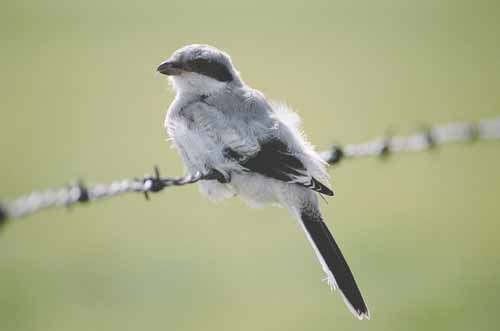Just as a butcher hangs meat out to dry, so does a threatened prairie songbird, the Loggerhead Shrike. "Instead of storing their meat in a meat locker as a butcher would, these birds impale and hang their prey on barbed wire fences, thorny shrubs, and trees, affording them the nickname of 'butcher bird'" says Rebecca Magnus, Habitat Stewardship Coordinator with Nature Saskatchewan. The shrike's prey items include beetles, grasshoppers, garter snakes, mice, voles, frogs, and even other smaller songbirds. Similar to other birds of prey, these birds have hooked bills. However, unlike most birds of prey, shrikes lack strong talons, and instead must impale a prey item in order to secure it during feeding. The males even use their impaled prey as a means to impress prospective mates.
Late June and throughout July is the ideal time to see Loggerhead Shrikes. Mid to late June is when the young have hatched (after 15 to 17 days of incubation), and the adults can be seen bringing food to their growing young. "The Loggerhead Shrike young grow quickly, and within two weeks of hatching, are up to 15 times their original size, so that they are nearly as big as their parents!" says Magnus. Their nests are made of twigs, grasses, forbs, and cattle or horse hair if available, and are found in native thorny shrubs such as buffaloberry and hawthorn, as well as shelterbelts and small trees. The young leave the nest in early July when they learn to fly and begin to impale their own prey. "This is probably the most fascinating time to see them as the young may be in small groups of 4 to 7, hanging out waiting to practice their hunting skills" notes Magnus.
Loggerhead Shrikes are slightly smaller than the American Robin with a black mask that extends from the bill past the eyes. These birds earn the "Loggerhead" part of their name because they have relatively large heads and the "Shrike" part of their name because they have a high pitched shriek for an alarm call. Nature Saskatchewan is asking anyone who sees a Loggerhead Shrike to please report the sighting. By reporting Loggerhead Shrikes, you provide valuable information about population size and distribution in order to help direct the conservation efforts for this threatened bird. Information will not be shared without a landowner's permission.




